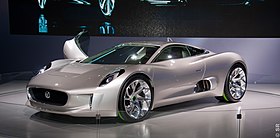| Jaguar C-X75 | |
|---|---|
 | |
| Overview | |
| Manufacturer | Jaguar Cars |
| Production | 2010–2013 |
| Designer | Ian Callum |
| Body and chassis | |
| Class | Sports car (S) |
| Body style | 2-door coupé |
| Layout | Rear mid-engine, all-wheel drive |
| Doors | |
| Powertrain | |
| Engine |
|
| Electric motor |
|
| Power output |
|
| Transmission |
|
| Hybrid drivetrain |
|
| Battery | 19 kWh liquid-cooled lithium-ion battery[1] |
| Range |
|
| Dimensions | |
| Length | 4,646 mm (183 in)[1] |
| Width | 2,040 mm (80 in)[1] |
| Height | 1,160 mm (46 in)[1] |
| Kerb weight | 1,700 kg (3,748 lb)[1] |
| Chronology | |
| Predecessor | Jaguar XJ220 (spiritual) |
The Jaguar C-X75 is a hybrid-electric, 2-seat, concept car produced by British automobile manufacturer Jaguar Cars in partnership with the derivative of the Formula One team, Williams Advanced Engineering, which debuted at the 2010 Paris Motor Show. The powertrain of the C-X75 concept is rated at 778 hp (789 PS; 580 kW) through four YASA electric motors,[2] each of which drives one of the four wheels. The batteries driving these motors are recharged using two diesel-fed micro gas turbines instead of a conventional four-stroke engine.[3] It was described as a design study that would influence future design and technology.[4]
In May 2011 Jaguar announced a limited production of the C-X75 from 2013 to 2015, with a compact, forced induction petrol engine combined with electric motors instead of the micro gas turbines in the concept car. A maximum of 250 cars were planned to be built in partnership with Williams Advanced Engineering. The production version was expected to have an all-electric range of 50 km (31 miles).[5][6] In December 2012, the company announced the cancellation of production due to the Great Recession. Five developmental prototypes were produced in the production car specifications in 2013.[7] The car was featured in the 2015 film Spectre, the twenty-fourth James Bond film in which seven cars were supplied to the film makers.[8]
- ^ a b c d e f g h Cite error: The named reference
spwas invoked but never defined (see the help page). - ^ "YASA Motors' Work for Jaguar Land Rover Wins Industry Commendation" (Press release). YASA. 26 November 2013. Archived from the original on 7 July 2017. Retrieved 8 July 2016.
- ^ "First Look: Jaguar C-X75 Concept". Motor Trend. 28 September 2010. Archived from the original on 11 August 2011. Retrieved 9 October 2010.
- ^ Cite error: The named reference
CarmagOct2010was invoked but never defined (see the help page). - ^ Cite error: The named reference
GCC050611was invoked but never defined (see the help page). - ^ Cite error: The named reference
BBC050611was invoked but never defined (see the help page). - ^ Mark Tisshaw (11 December 2012). "Jaguar C-X75 axed". Autocar. Retrieved 11 December 2012.
- ^ Moss, Darren (9 February 2015). "Jaguar C X75 in James Bond film Spectre". Autocar. Retrieved 14 February 2015.